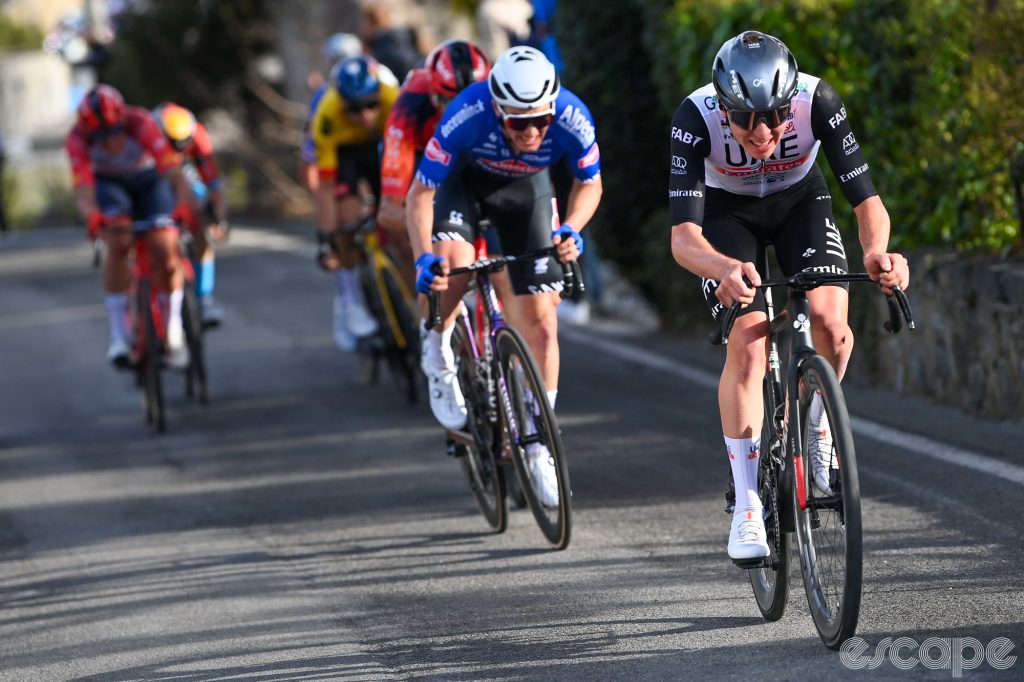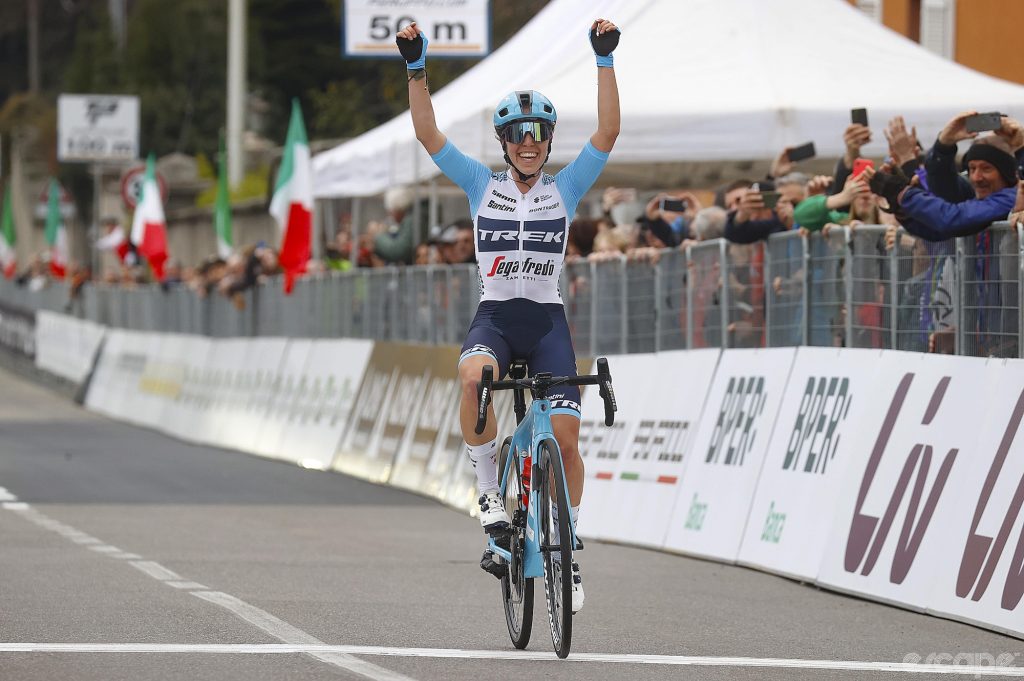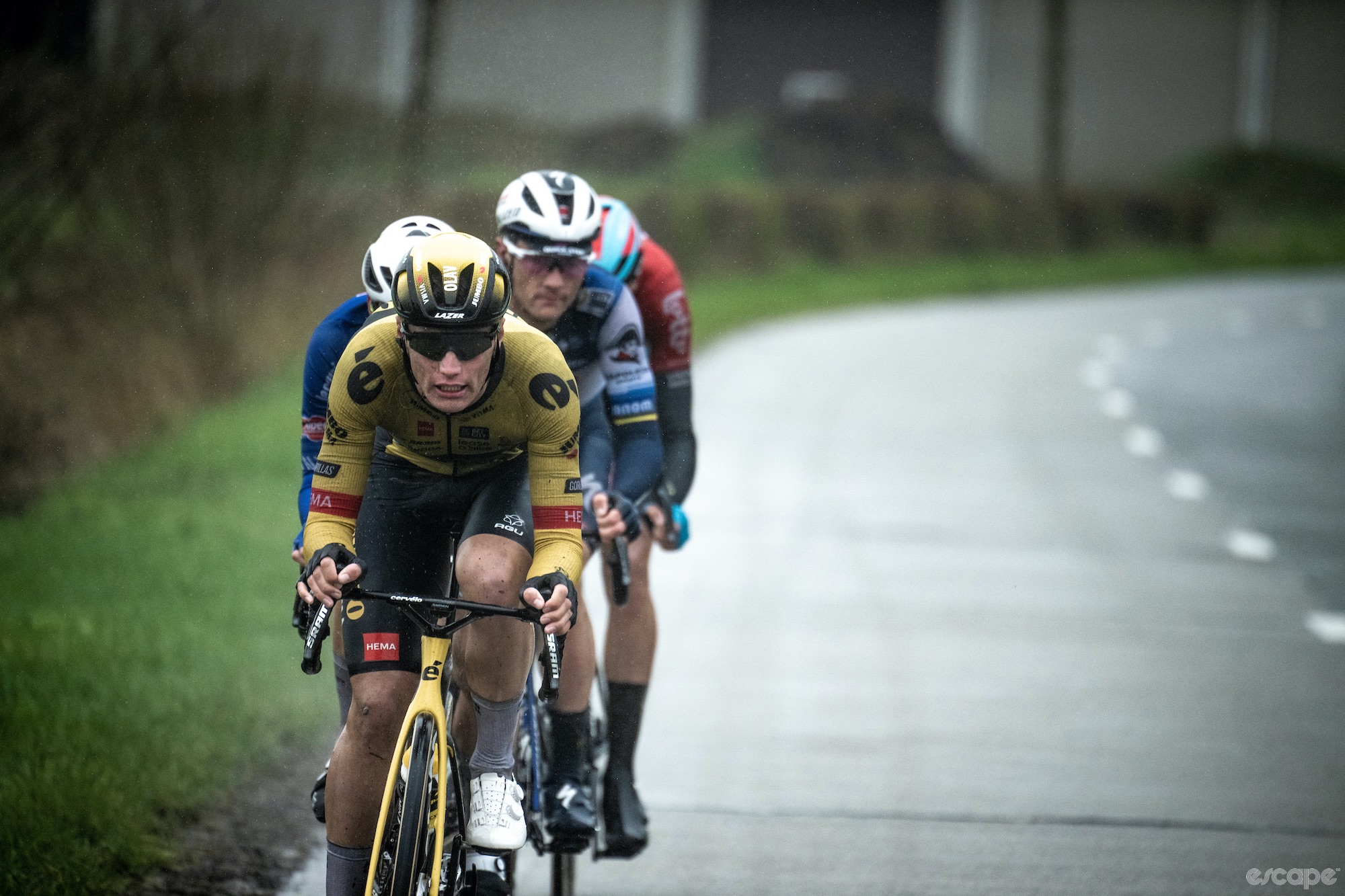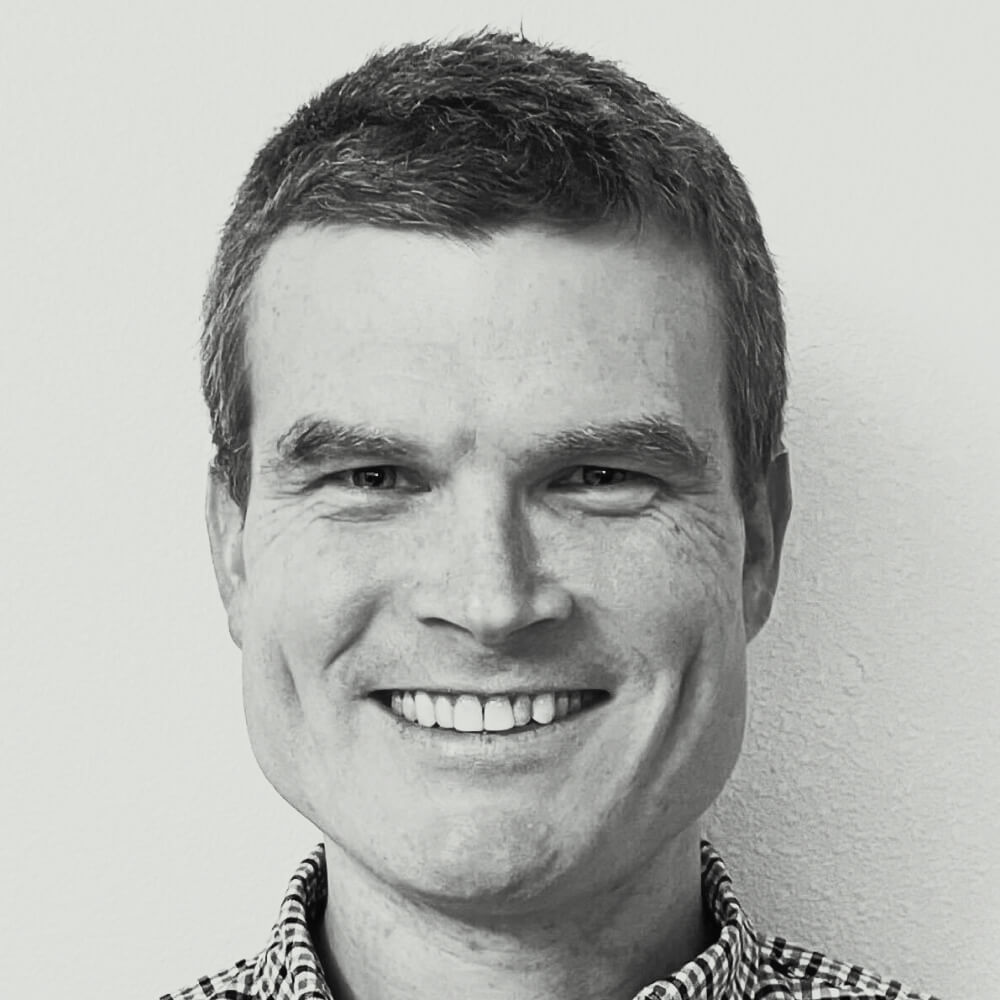As racing starts to heat up this year, familiar teams are time and time again showing up near the top of WorldTour leaderboards every week. On the men’s side, UAE Team Emirates, the Ineos Grenadiers, and Jumbo-Visma have been performing as expected. On the women’s side Trek-Segafredo and SD Worx are leading the way thus far.
Dig back into team rankings a decade ago, however, and what you find may surprise you. The (pre-Ineos) Sky and the (pre-SD Worx) Boels-Dolmans powerhouses were rolling right along of course, but Jumbo-Visma predecessor Belkin was a mid-pack organization, UAE predecessor Lampre-Merida was nowhere near the top of the rankings, and Trek didn’t even have a women’s team yet.
How have the great squads stayed great in that time, and how have the relative newcomers to the elite tier done it? Budgets obviously play a big role, but all the money in the world can only do so much if you can’t sign great riders. At the end of the day, it is the teams that have spent their money wisely that have thrived, and as champions from the Tour to Worlds get ever younger each year, that largely comes down to one key aspect of running a professional team in any sport: talent scouting.
For all the big headlines that veteran stars generate in transfer season, many of the sport’s top names of the moment are racing on their first WorldTour outfit. So how did they end up where they did?
We’re glad you asked, because identifying talents of that caliber at a young age – and convincing them to sign on the dotted line – can make all of the difference between a bottom-feeder WorldTour outfit and the peloton’s top teams. The question is how teams effectively find those talents in the first place.

It starts with young riders, perhaps even younger than you’d think in some cases. Even the very hottest prospects generally don’t join WorldTour teams until they’re very close to 20 years old, but they may have been on the radars of the people who do this sort of thing for a living for a while. Talent scouts keep a close eye on junior racing to spot up-and-coming riders.
Develop in-house or independently?
Indeed, for WorldTour outfits like Jumbo-Visma or DSM that invest in the operation of a dedicated development squad, those very young prospects are the central focus. For Robbert De Groot, head of the Jumbo-Visma development team, the hope is that his squad can get in on the proverbial ground floor with a promising youngster. That requires not only the investment in that development team, but also the ability to gauge the rider’s chances of success from even further out. That means looking for a balance of youth and maturity.
“You need maturity in your physical and mental approach because it is an extremely hard sport and it’s not like a technical or more coordinated sport like gymnastics or football or hockey,” De Groot says.
“The physical and mental ability in these extremely hard endurance sports are not developed when you’re 12 or 13 years old. They are developed older. So we start at 15, 16, around that age.”
Organizations without that built-in development pathway will also pay close attention to riders from the time they enter the junior ranks. They might make arrangements for those riders to continue to grow on other development teams with an eye towards staying informed on their progress and signing them a little further down the road.
Staying informed is easier on the men’s side than it is on the women’s side, where the infrastructure for younger riders is less robust.
“I would say it’s depending on the countries,” Trek-Segafredo manager Luca Guercilena says. “We all know that [female] juniors in Italy and Holland essentially are already, I would say equal [to male juniors], but in many other countries the level is very poor in the equity between men and women, so it’s more complicated to find a good bunch of girls to which we can propose this kind of stuff.”
Results are just the start
Whether the dataset is large, as it would be for a Tour de l’Avenir racer on the cusp of signing a WorldTour deal, or still small, as it might be for a junior women’s racer just starting out, the results are just a starting point for scouts. From there, the real work begins.
For UAE Team Emirates sports manager Joxean Matxin Fernández, who helped bring a young Tadej Pogačar to the WorldTour, it’s important to understand that the leaderboard doesn’t always tell the whole story.

“If a 20-rider break goes with all of the teams, then it’s the break that gets to the finish. The best rider was not the one who won. Maybe he finished eighth or 10th. That sort of talent is seen indirectly, not just in the results.”
Specific physical attributes are further examined through testing. WorldTour squads bring prospects into sports science labs to get a closer look at a wide array of abilities. Trek-Segafredo, for instance, uses the Mapei lab (yes, that same Mapei is still involved in sports) in Italy to test prospects.
The VO2max numbers of up-and-comers often make headlines, as was the case for a young Egan Bernal a few years ago, but there are other benchmarks to check as well. The scouting experts that spoke to Escape Collective on the subject pointed to various power numbers, VLamax (maximal lactate production rate), and lactate metabolism as other data points they use to gauge performance.
The way EF Education-EasyPost manager Jonathan Vaughters describes the process resembles a sort of flow chart.
“Each one of these things is sort of like a hurdle,” Vaughters says. “Does he know how to race? OK. Does he know how to go around corners? OK, got that. Does he have a high VO2max? OK, got that. Good lactate metabolism? OK, got that.
“Each time it’s sort of like a barrier,” he continues. “[If] you would say, ‘No, he doesn’t? [then] OK, out of here.'”
The hardest part: intangibles
With a better understanding of a rider’s physiological profile, teams move into the realm of the psychological. Different teams value different attributes.
For Vaughters and EF, the personality fit is key.
“Usually if the rider’s really interested in coming to our team, they’re already kind of a quirky personality that we want on the team,” Vaughters says. “Like, we don’t get a whole lot of just blockheads coming to be part of EF, it’s usually like these, you know, kind of like, just more interesting characters.”
Guercilena explains that Trek puts a premium on finding riders who still approach cycling in a certain way even as they are nearing the pro ranks.
“For most, they need still to be in the phase of their life in which they just enjoy riding a bike,” Guercilena says. “We normally, I would say not refuse, but we are very doubtful if we find out that junior is already training like a pro. You know, he’s checking the weight of what he is eating or stuff like this. When they are too much [like] professionals, juniors, we know that their chance to fail is pretty high.”

Guercilena also values riders with cross-discipline talents. Ronde van Drenthe winner Shirin van Anrooij, for example, had already won a junior world title in cyclocross when Trek signed her.
Matxin lists motivation and racing intelligence as key factors in his search, along with certain traits that are innate and harder to define.
“I look for the attitude, the talent, and then that class that champions have.”
Whatever it is that gives a rider that “class,” you can safely assume that UAE superstar Tadej Pogačar possesses it in spades.
How diamonds are made
For De Groot at Jumbo-Visma, there is the added dimension of looking for younger riders who are at an earlier stage in the process to join the Jumbo-Visma Development squad and who will gel with the longer-term approach the team takes. That said, before the team created its development operation, they were obviously quite good at identifying talents already racing at the Continental level. Stars Jonas Vingegaard and Primož Roglič came aboard from third-division teams and things have worked out pretty well for them.

The best scouts can use all the information they gather to get a stronger sense of a rider’s potential beyond glaringly obvious results like top finishes in international junior events. In that regard, Olav Kooij is an example of a success story for De Groot and Jumbo. He scored some results at junior races in his teenage years, but it wasn’t as if he was winning world titles in his age group. Still, Jumbo-Visma saw potential for growth.
“Olav popped up as a rider who showed himself in sprinting and who showed himself in different, a little bit harder, stage races where he could beat kind of all the juniors that were involved at that time,” De Groot says. “The good thing also was that he also was involved in speed skating. And as you might know, speed skating in Holland is on quite a big level. He was probably not the best speed skating talent, but he was good.
“So there was a certain winter training in the speed skating and there was a certain summer training in the cycling training, which means there was a lot of space to develop his cycling because he never did a lot of cycling in winter.”
At the Jumbo development team, Kooij put his focus squarely on racing bikes, and he has since developed rapidly, moving up to the WorldTour squad during the 2021 season. He won 12 races last year, including the overall at the ZLM Tour, and took his second WorldTour win this month on Stage 5 at Paris-Nice.
Timing your jump for the win
For outfits with a development team, the goal is to add prospects who are still a little ways off from the WorldTour level, so that by the time the rider is ready to make that jump, they’re already integrated into the squad’s broader system. In those situations, it’s a matter of giving the rider reasons to buy in to the longer term project.
At those teams looking to bring on riders at the WorldTour level, meanwhile, capable scouts and managers will have a wealth of information at hand when it comes time for signing day.
As a young rider, this is when all those years of training and juniors racing finally pay off, literally. For the teams trying to acquire those youngsters, it’s the familiar feeling of racing to win (a signature, in this case) against a crowded field of fierce competitors. As you might expect, cold hard cash is a huge part of the equation.
It’s hardly a surprise, then, that many of the teams with a reputation for churning out young superstars also happen to have healthy budgets. Talent scouting is only so helpful if you can’t close the deal with a young rider because someone else is willing to pay that prospect more. As such, teams like the Ineos Grenadiers know that they can spend their time scouting out the best of the best, knowing a rider in whom they’ve invested deeply won’t bail to sign with a higher-paying team.
Still, that doesn’t mean that those squads with smaller piggybanks are completely out of luck. For starters, even the smaller WorldTour teams can gamble on a handful of sizable deals. The problem is that the bigger teams can afford to hand out more of those, which means that mid-budget teams need to perfect their pitch to any highly coveted prospect who might be able to get the same offer or a better one elsewhere. The pitch is different from team to team.
Vaughters says that EF, for example, likes to emphasize the team culture. Guercilena says that Trek can point to developmental successes with those who have spent years racing for the team as a selling point. And in any case, this is a place where relationships that have been cultivated since the rider’s first emergence as a prospect can really make a difference.
If all else is equal, the team that has spent years in friendly contact with a prospect has a leg up on the one that is just getting to know the rider. In fact, those relationships can even pay dividends a little further down the road. Matxin points to his early contacts with a young João Almeida, who went on to ride in two different Continental teams before joining the Quick-Step organization, as being helpful in signing Almeida to UAE as a slightly older – though still quite young – pro.
At the end of the day, team managers hope that some combination of everything they have to offer will be enough to inspire a young man or woman to sign on the dotted line.
After that, it’s up to the riders to develop and ultimately perform, with the help of the team support staff.
As for the talent scouts, they might spend the next few years hoping that happens, and that they’ve discovered the next big thing – but sooner or later they go back to work to find the next next big thing.
What did you think of this story?

